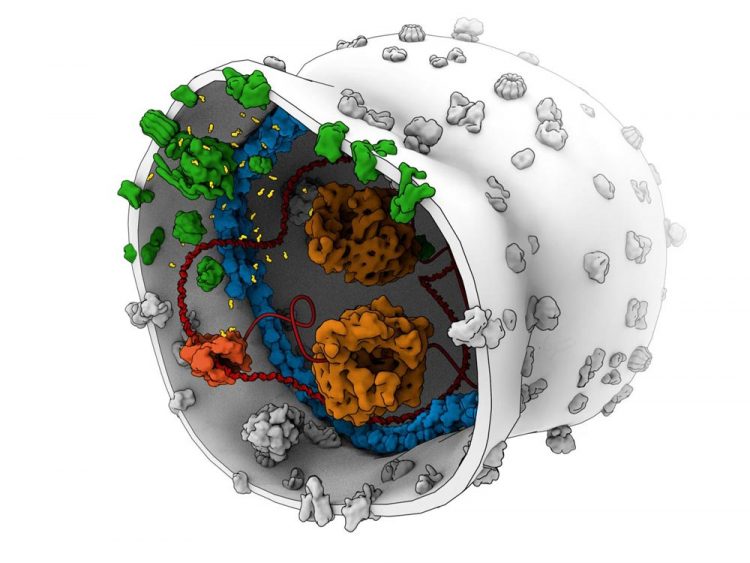Scientists construct energy production unit for a synthetic cell

This is an artist's impression of a synthetic cell, with the ATP production system in green. Credit: Bert Poolman / BaSyC consortium
'Our aim is the bottom-up construction of a synthetic cell that can sustain itself and that can grow and divide,' explains University of Groningen Professor of Biochemistry Bert Poolman. He is part of a Dutch consortium that obtained a Gravitation grant in 2017 from the Netherlands Organisation for Scientific Research to realize this ambition. Different groups of scientists are producing different modules for the cell and Poolman's group was tasked with energy production.
Equilibrium
All living cells produce ATP as an energy carrier but achieving sustainable production of ATP in a test tube is not a small task. 'In known synthetic systems, all components for the reaction were included inside a vesicle. However, after about half an hour, the reaction reached equilibrium and ATP production declined,' Poolman explains. 'We wanted our system to stay away from equilibrium, just like in living systems.'
It took three Ph.D. students in his group nearly four years to construct such a system. A lipid vesicle was fitted out with a transport protein that could import the substrate arginine and export the product ornithine. Inside the vesicle, enzymes were present that broke down the arginine into ornithine.
The free energy that this reaction provided was used to link phosphate to ADP, forming ATP. Ammonium and carbon dioxide were produced as waste products that diffused through the membrane. 'The export of ornithine produced inside the vesicle drives the import of arginine, which keeps the system running for as long as the vesicles are provided with arginine,' explains Poolman.
Transport protein
To create an out-of-equilibrium system, the ATP is used to maintain ionic strength inside the vesicle. A biological sensor measures ionic strength and if this becomes too high, it activates a transport protein that imports a substance called glycine betaine. This increases the cell volume and consequently reduces the ionic strength. 'The transport protein is powered by ATP, so we have both production and use of ATP inside the vesicle.'
The system was left to run for 16 hours in the longest experiment that the scientists have performed. 'This is quite long – some bacteria can divide after just 20 minutes,' says Poolman. 'The current system should suffice for a synthetic cell that divides once every few hours.' Eventually, different modules like this one will be combined to create a synthetic cell that will function autonomously by synthesizing its own proteins from a synthetic genome.
Artificial chromosome
The current system is based on biochemical components. However, Poolman's colleagues at Wageningen University & Research are busy collecting the genes needed for the production of enzymes used by the system and incorporating them into an artificial chromosome. Others are working on lipid and protein synthesis, for example, or cell division. The final synthetic cell should contain DNA for all these modules and operate them autonomously like a living cell, but in this case, engineered from the bottom-up and including new properties. However, this is many years away. 'In the meantime, we are already using our ATP-producing system to study ATP-dependent processes and advance the field of membrane transport,' says Poolman.
###
Reference: Tjeerd Pols, Hendrik R. Sikkema, Bauke F. Gaastra, Jacopo Frallicciardi, Wojciech M. Smigiel, Shubham Singh and Bert Poolman: A synthetic metabolic network for physicochemical homeostasis. Nature Communications 18 September 2019
Media Contact
More Information:
http://dx.doi.org/10.1038/s41467-019-12287-2All latest news from the category: Life Sciences and Chemistry
Articles and reports from the Life Sciences and chemistry area deal with applied and basic research into modern biology, chemistry and human medicine.
Valuable information can be found on a range of life sciences fields including bacteriology, biochemistry, bionics, bioinformatics, biophysics, biotechnology, genetics, geobotany, human biology, marine biology, microbiology, molecular biology, cellular biology, zoology, bioinorganic chemistry, microchemistry and environmental chemistry.
Newest articles

High-energy-density aqueous battery based on halogen multi-electron transfer
Traditional non-aqueous lithium-ion batteries have a high energy density, but their safety is compromised due to the flammable organic electrolytes they utilize. Aqueous batteries use water as the solvent for…

First-ever combined heart pump and pig kidney transplant
…gives new hope to patient with terminal illness. Surgeons at NYU Langone Health performed the first-ever combined mechanical heart pump and gene-edited pig kidney transplant surgery in a 54-year-old woman…

Biophysics: Testing how well biomarkers work
LMU researchers have developed a method to determine how reliably target proteins can be labeled using super-resolution fluorescence microscopy. Modern microscopy techniques make it possible to examine the inner workings…





















